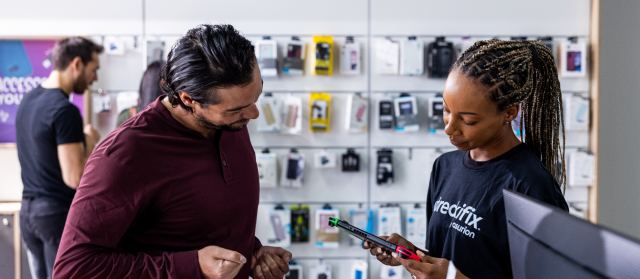Getting your phone or device repaired doesn't have to be stressful, but it's completely understandable to have concerns about your personal information when you need to hand over your device. The good news is that with a few straightforward steps, you can protect your data and feel confident about the repair process.
Whether you're dealing with a cracked screen, battery issues, or software problems, it's always a good idea to take a little time to secure your information beforehand so you don’t risk losing important information. Here's everything you need to know to keep your data safe while getting your device fixed.
Why data privacy matters during a repair
Your smartphone and other connected devices store an incredible amount of personal information. From private photos and messages to banking apps and work emails, these devices have become digital extensions of our lives.
Understanding what happens during the repair process and taking proactive steps to secure your data helps make sure your privacy remains intact. While most repair services operate with integrity and have policies in place to protect customer information, being prepared gives you control over your personal data and peace of mind during what can already be a stressful situation.
What happens to your device at a repair center
When you drop off your device for repair, it typically passes through several technicians before you get it back. Depending on the service you need, repair professionals will typically need to:
- Diagnose the problem.
- Test functionality.
- Run software updates when necessary.
- Verify that repairs work properly.
How repair services protect your information
Reputable repair services have established protocols to protect customer data. Professional technicians receive training to focus specifically on repair tasks and avoid accessing personal information. Many repair centers use specialized diagnostic tools that can test device functionality without requiring access to personal files or data.
That said, your device contains sensitive information, including photos, messages, banking apps, work emails, and personal documents. Taking your own protective measures ensures your data stays secure regardless of the repair shop's policies.
Steps to protect your data before a repair
Step 1: Back up your data
Creating a complete backup is your first line of defense. This protects you if anything goes wrong during the repair process and makes sure your important information is safely stored elsewhere.
- iPhone: Navigate to Settings > [Your Name] > iCloud > iCloud Backup, then select Back Up Now.
- Android: Go to Settings > System > Backup, then enable Back up to Google Drive.
To back up to a computer:
- Connect your device to your computer using a USB cable.
- iPhone: Use iTunes or Finder to create a local backup.
- Android: Use your device manufacturer's software (Samsung Smart Switch, HTC Sync, etc.) or transfer files manually.
Use encrypted backups when possible
- In iTunes, select Encrypt local backup before beginning.
- Cloud backups from Apple and Google are automatically encrypted.
Step 2: Remove personal security settings
Security features protect your device from unauthorized access, but they can interfere with repair diagnostics. You'll need to temporarily disable these settings.
- Turn off screen lock passwords (PIN, pattern, or biometrics). You can re-enable them when you get your device back.
- Turn off Find My iPhone or Find My Device.
Step 3: Log out of accounts
Signing out of your accounts prevents unintended access to your personal information.
If your phone won’t turn on:
- Change passwords for important accounts using another device. Consider how to create a strong password.
- Sign out of all active sessions through your account settings.
- Enable two-factor authentication for additional security.
Questions to ask before handing over your device
- Do you wipe data before repairs?
- How long is data retained, if at all?
- Who has access to my phone?
How Asurion helps keep your information safe
Asurion takes data privacy seriously across all uBreakiFix® by Asurion repair locations. Their experts receive comprehensive training on customer privacy and proper data handling procedures.
Asurion data handling policies
Asurion has developed comprehensive policies governing how customer devices and data are handled during repairs. These policies prioritize minimizing data access, protecting customer privacy, and ensuring that personal information remains secure throughout the entire repair experience.
When you choose Asurion for device repair, you're working with a company that understands the importance of data privacy and has built its repair processes around protecting customer information. For additional support, you can always turn to our tech help.
FAQ
What should I do with my data before a phone repair?
Back up your data, log out of accounts, and temporarily disable screen locks and Find My Device.
Can technicians see my information during a repair?
While professional technicians focus on repair tasks, it’s possible they could access your info if the phone is unlocked.
Do I need to remove my SIM card before getting a repair?
Yes, it’s generally recommended to remove your SIM card.
Why does the repair technician need my password?
To test device functions, install updates, or run diagnostics.
What questions should I ask before a repair to protect my data?
Ask about policies for data wipes, retention, and access.
How does Asurion protect my data during a repair?
Asurion employs certified experts who follow strict data privacy protocols, focusing only on repair-related tasks.
